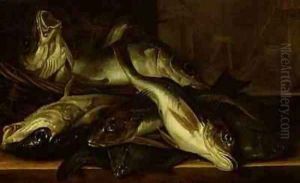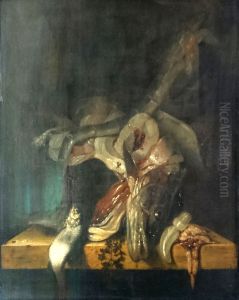Jacob Gillig Paintings
Jacob Gillig was a Dutch Golden Age painter, born in Utrecht, the Netherlands, in 1636. Known primarily for his detailed and realistic still lifes, particularly of fish and marine subjects, Gillig carved out a niche for himself in a period that was rich with artistic innovation and achievement. His work is characterized by its meticulous attention to detail, vibrant colors, and the ability to bring everyday scenes to life with a remarkable sense of realism.
Gillig's career spanned a significant portion of the 17th century, a time when the Dutch Republic was at the height of its power and cultural influence. This era, known as the Dutch Golden Age, saw a flourishing of arts and sciences, with painting being one of the most celebrated forms of artistic expression. Artists during this period focused on various genres, including landscapes, portraits, still lifes, and marine scenes, the latter being Gillig's area of specialization.
Despite the competition from numerous talented artists of his time, Jacob Gillig managed to gain recognition and acclaim for his unique focus on fish and marine life. His paintings often depicted the bounty of the sea with an almost scientific accuracy, showcasing not just the beauty of his subjects but also their anatomical details. This has led historians and art critics to appreciate his works not only for their artistic merit but also for their contribution to the natural history studies of his time.
Gillig's life, after his initial training in Utrecht, was dedicated to his art. He remained active in the art scene until his death in 1701. Although not as widely known as some of his contemporaries, Gillig's work has been appreciated by art collectors and historians, particularly those with an interest in the Dutch Golden Age and the development of still life painting. His paintings are held in various museum collections around the world, serving as a testament to his skill and the enduring appeal of his chosen subject matter. Jacob Gillig's contribution to Dutch art, especially in the realm of marine still life, remains an important part of the legacy of the Golden Age of Dutch painting.



